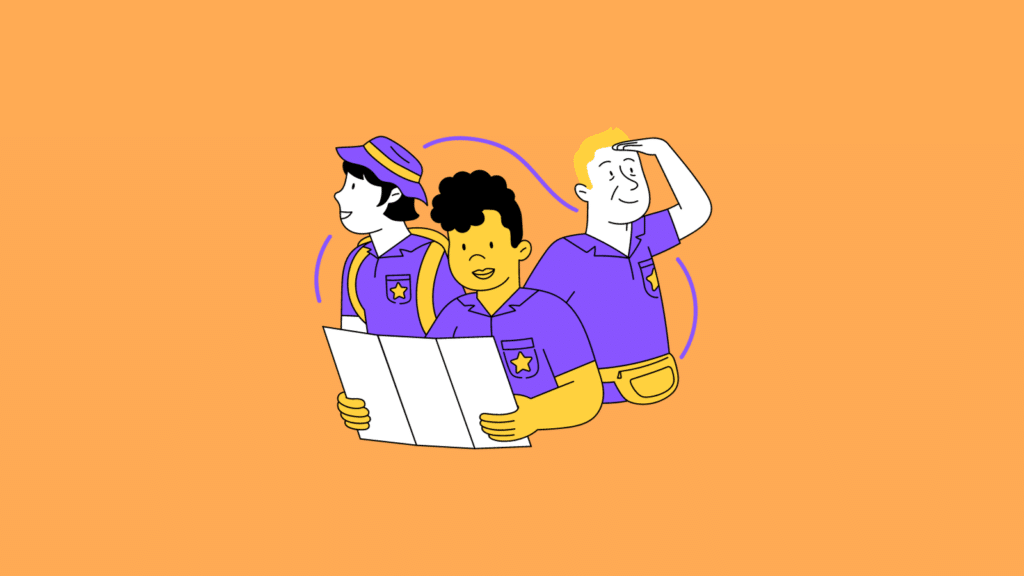PTO vs Vacation: What Are the Differences?
As companies embrace more flexible approaches, paid time off (PTO) has become increasingly intricate, leaving many employees perplexed about the distinctions between PTO and the cherished vacation days they eagerly anticipate. If you find yourself navigating this endless maze of time-off policies, wondering about the nuances that could shape your work-life balance, you’re in the right place.
This guide aims to clarify the differences between PTO and vacation and offer insights to help you make informed choices that suit your individual needs.
Easily manage all types of employee time off in one place: paid time off, sick days, time off in lieu, and many more
What is PTO?
Paid Time Off (PTO) is a human resource management policy that encompasses various types of leave, including vacation, personal, and sick leave.
This consolidation offers employees greater flexibility and autonomy in determining how they utilize their allotted time off.
Purpose of PTO
The primary purpose of PTO is to enhance the work-life balance of employees by acknowledging that time away from work is essential for overall well-being. PTO recognizes that individuals may require time off for various reasons, be it for rest, personal obligations, or health-related concerns.
This approach reflects a more modern and inclusive perspective on leave policies, accommodating the diverse needs of today’s workforce.
Benefits of PTO
- Flexibility: One key advantage of PTO is its flexibility. Employees can use their accrued PTO days for any purpose, whether a planned vacation, a personal day to attend to non-work-related matters or an unexpected situation like illness.
- Work-life balance: PTO promotes a healthier work-life balance by acknowledging the importance of downtime. Employees can recharge, spend quality time with family and friends, or address personal matters without the stress of work responsibilities.
- Reduced presenteeism: With a comprehensive PTO policy, there is less pressure for employees to come to work when unwell, reducing the phenomenon of presenteeism. This, in turn, contributes to a more productive and healthier work environment.
Common PTO policies and accrual methods
- Accrual methods: PTO can be accrued based on the length of an employee’s service or through a more straightforward accrual system, where employees earn a certain number of hours per pay period.
- Usage policies: Employers may have specific guidelines on how PTO can be used, such as advance notice requirements for planned vacations or restrictions during busy periods.
- Accrual caps: Some companies impose limits on the maximum amount of PTO an employee can accrue to prevent excessive accumulation.
- Paid holidays: Some organizations include paid holidays as part of their PTO policy, ensuring that employees receive compensation for designated public holidays.
What is a vacation?
Vacation, a treasured component of time-off policies, refers to a designated period during which employees are granted leave from work to engage in leisure, relaxation, and personal pursuits.
The primary purpose of vacation is to allow individuals to recharge, unwind, and step away from the demands of the workplace.
Unlike the more encompassing PTO, vacation time is specifically earmarked for leisure activities, family vacations, travel, or any other activities that contribute to an individual’s overall well-being.

Benefits of vacation
- Relaxation: The core benefit of vacation lies in providing individuals with dedicated time to relax and detach from the stresses of their professional responsibilities. This downtime is crucial for mental and emotional rejuvenation.
- Rejuvenation: Vacation allows individuals to recharge their physical and mental energy, promoting improved focus, creativity, and productivity upon their return to work. It serves as a preventative measure against burnout.
- Quality time: Whether spent with family, friends, or in solitary reflection, vacation time enables individuals to foster meaningful connections and create lasting memories, contributing to a more fulfilling life outside of the workplace.
Read also: Coping with stress at work
Common vacation policies and accrual methods
- Accrual methods: Like PTO, vacation time can be accrued based on an employee’s tenure with the company or through a straightforward accrual system, where individuals earn a set number of vacation days per pay period.
- Usage policies: Companies often have guidelines for how vacation time should be requested and used. This may include advance notice requirements, especially for extended vacations, to ensure proper workflow management.
- Accrual caps: Employers may set limits on the maximum amount of vacation time an employee can accrue, encouraging regular usage and preventing excessive accumulation.
- Blackout periods: Some companies impose blackout periods, restricting the use of vacation during peak business times or specific seasons when a high level of employee presence is crucial.
- Use-it-or-lose-it policies: To promote regular breaks and discourage stockpiling of vacation days, certain organizations implement use-it-or-lose-it policies, where unused vacation days do not carry over to the next accrual period.

PTO vs vacation: The key differences
1. Usage
- PTO
Versatility: PTO is an umbrella term that allows employees the flexibility to use their accrued days for various reasons, including vacations, personal matters, or unexpected circumstances like illness.
Broad application: Employees can utilize PTO for both planned and unplanned absences, making it a more adaptable option for managing time away from work.
- Vacation
Specific purpose: Vacation time is specifically designated for leisure and relaxation. It is intended for planned breaks from work to rejuvenate and engage in personal activities, travel, or spend quality time with family and friends.
2. Accumulation
- PTO
Comprehensive accrual: PTO combines various types of leave, which may include vacation days, personal days, and sick leave. This consolidation allows for a more comprehensive approach to time-off accrual.
Unified bank: Accrued PTO is typically stored in a unified bank, providing a pool of hours or days that employees can draw from for different purposes.
- Vacation
Specific to leisure: Vacation accrual is specifically tied to leisure time, reflecting a more traditional approach to time-off policies segregating different types of leave.
3. Flexibility
- PTO
Adaptable usage: The flexibility of PTO lies in its adaptability. Employees can use accrued PTO for any purpose, offering a versatile solution that aligns with the diverse needs of a modern workforce.
- Vacation
Dedicated purpose: Vacation days are allocated for leisure and are not as versatile as PTO. While they contribute significantly to work-life balance, their application is limited to planned time away for relaxation.
4. Company policies and culture
- PTO impact
Companies with a PTO-centric approach tend to prioritize flexibility and acknowledge the diverse reasons employees may need time off.
PTO policies often align with a more modern and inclusive workplace culture that values work-life balance and individual well-being.
- Vacation impact
Organizations emphasizing specific vacation policies may foster a culture that values dedicated breaks for rest and rejuvenation.
Vacation-focused cultures may encourage employees to plan and take extended breaks to prevent burnout and enhance overall job satisfaction.
Understanding the differences in usage, accumulation, and flexibility between PTO and vacation is crucial for employees navigating time-off policies. The impact of company policies and culture further underscores the importance of aligning personal preferences with the prevailing ethos of the workplace.

Factors to consider when choosing PTO or vacation
- Purpose of time off
- PTO: If the need for time off encompasses various purposes, such as personal days, relaxation, and potential unforeseen events, PTO offers the flexibility to address these diverse needs.
- Vacation: When the primary goal is rest, relaxation, and leisure, dedicated vacation days may be the more appropriate choice.
- Flexibility requirements
- PTO: Opt for PTO when flexibility in the usage of leave days is essential. This allows for spontaneous breaks or addressing unexpected personal or family matters.
- Vacation: Designated vacation days may offer a more structured approach if planning and having a specific timeframe for relaxation is a priority.
- Company policies
- Consider the existing policies of your company. If the workplace has a strong PTO culture, aligning with this approach may be advantageous. Similarly, if the organization emphasizes traditional vacation policies, it’s essential to adhere to these guidelines.
- Accrual balance
- Evaluate your accrued balance for both PTO and vacation. If one balance is significantly higher than the other, it may influence your decision. For instance, if you have a surplus of PTO, it might be more practical to use those days for various purposes.

Scenarios and suitability
- Last-minute plans
- PTO: Ideal for spontaneous or last-minute plans, such as a sudden need for personal time or an impromptu day off.
- Vacation: Better suited for planned breaks, especially for longer durations or trips that require advance arrangements.
- Health and well-being
- PTO: If you have health-related concerns or need intermittent breaks for self-care, PTO provides the flexibility to address these needs.
- Vacation: For comprehensive rejuvenation and mental well-being, a dedicated vacation might be more suitable.
- Family events
- PTO: Valuable when you need time off for various family-related events, such as birthdays, graduations, or special occasions.
- Vacation: Especially suitable for family vacations or planned trips where the focus is on spending quality time with loved ones.
- Workload and project deadlines
- PTO: When facing a high workload or tight project deadlines, using PTO for shorter breaks or sporadic days off can provide a breather without disrupting long-term plans.
- Vacation: Ideal for longer breaks when you can ensure that work responsibilities are appropriately delegated or managed in your absence.
Read also: How to manage workload at work

Tips for effective utilization
- Plan: Whether you opt for PTO or vacation, planning allows you to better coordinate your work responsibilities and ensures a seamless transition during your absence.
- Communication: Communicate your time-off plans to supervisors and colleagues. Providing ample notice and keeping everyone in the loop helps manage expectations and workflow.
- Balance accumulation: Regularly assess and balance your accrued PTO and vacation days. Strive to use your time off regularly to prevent excessive accumulation or potential use-it-or-lose-it scenarios.
- Consider workload impact: Evaluate the impact of your absence on ongoing projects and workload. Choose the type of leave that aligns with the demands of your role, ensuring a smooth workflow during your time away.
- Mix and match: Depending on your company’s policies, consider combining PTO and vacation strategically. This allows for a blend of flexibility and dedicated leisure time.
- Reflect on personal needs: Consider your well-being and what type of break aligns with your current needs. Whether it’s a spontaneous day off for self-care or a planned vacation for extended relaxation, prioritize what contributes most to your overall happiness and balance.
By thoughtfully considering these factors and scenarios, individuals can make informed decisions when choosing between PTO and vacation, ultimately enhancing their work-life balance and well-being.
Slutsats
In unraveling the distinctions between Paid Time Off (PTO) and vacation, we’ve identified key factors influencing the choice between flexibility and dedicated leisure.
PTO’s adaptability caters to diverse needs, while vacation provides structured respite for planned breaks. Understanding the impact of company policies and aligning choices with individual needs is essential.
Whether opting for the versatility of PTO or the focused relaxation of vacation, readers are encouraged to consider factors such as purpose, flexibility requirements, and workplace culture. Effective utilization involves planning, communication, and maintaining a balanced accrual.
As you navigate your time-off decisions, remember that informed choices contribute significantly to a harmonious work-life balance, fostering well-being and professional satisfaction.
- TIP: Manage PTO and vacation like a pro with workforce management software.
VANLIGA FRÅGOR
What is the difference between PTO and vacation?
PTO is a comprehensive leave policy that includes various types of leave, while vacation specifically refers to time off for leisure and relaxation.
Is it better to use PTO than vacation?
The choice depends on personal needs. PTO offers more flexibility, while vacation is dedicated to leisure. Consider your purpose for time off.
Can PTO be used for sick days?
Yes, PTO is often inclusive of sick leave. It provides flexibility to use accrued days for planned or unplanned absences, including illness.
How is PTO calculated?
PTO calculation methods vary, commonly based on years of service or accrual per pay period. Check your company’s policy for specific details.
How does vacation accrual work?
Vacation accrual involves earning a set number of days per pay period or year based on company policy and tenure.
Can I carry over unused PTO or vacation days?
Policies differ, but some companies allow the carryover of unused PTO or vacation days, while others may have use-it-or-lose-it policies.
Can I request PTO or vacation in advance?
Yes, advance notice for time-off requests is common practice. Check your company’s policy for specific guidelines.
Can I be forced to work during PTO or vacation?
Generally, employers cannot force employees to work during approved PTO or vacation days. Respect for personal time is standard practice.
What does PTO mean for holidays?
PTO policies may include or exclude holidays. Check your company’s policy to understand if holidays are part of your PTO allocation.
Should I track my time off?
Yes, tracking time off is crucial for managing accrual balances and ensuring compliance with company policies.
What happens if I don’t use my vacation days?
Policies vary, but unused vacation days may be forfeited, or some companies may allow a carryover. Check your company’s specific guidelines.
Du kanske är intresserad av:
